For this assignment you will use the statistical knowledge a
For this assignment, you will use the statistical knowledge and scientific writing skills acquired in this course to complete the Signature Assignment (Mock Study). Carefully review the information provided about the mock study, and then address each assignment requirement. You are the Director of Institutional Research at a small state university and you have been given the task of gathering information for the Dean of the School of Education regarding the performance of its undergraduate students on the Graduate Record Exam (GRE). Data on six variables were collected: gender, overall grade point average (GPA), major GPA, GRE scores in major area, GRE quantitative, GRE verbal, and type of preparation programs. The university is dedicated to maximizing student success on the GRE. The university has established five different options for students to prepare for the GREs: option 1 = completely online asynchronous prep course, 2 = completely online synchronous prep course, 3 = complete a hybrid prep course with a combination of online and face to face; 4 = complete a traditional instructor led prep course, and 5 = self-paced paper based prep course. The Dean has simply said to you, “Tell me what works best and for whom?” You decide to establish a pilot study with 50 randomly selected general science education seniors to determine the details of the methodology as well as to provide some initial data and corresponding results to learn if the research plan meets the Dean’s needs. The pilot study needs to contain the following components written in APA format: Part 1: Develop a clear purpose statement sentence capturing the essence of the intent of the pilot study. Develop a brief introduction including three research questions (with the use of corresponding symbols or Q1., Q2., Q3.) related to the purpose of the pilot study. For each of the three research questions, develop a null and alternative hypothesis (with the use of corresponding symbols or Ho1:, Ha1:, Ho2:, Ha2:, Ho3:, Ha3:). Using a statistical decision chart similar to Gragetter and Wallnau (2013) Chapter 19, select the appropriate statistical test/analysis for each research question. Briefly explain the choices for each research question. Conduct each analysis using SPSS on the SPSS data set developed in the Create a Mock Data Set in Week 7. The output of those tests should be placed in an Appendix for the final report to the Dean. Present and discuss the findings (as related to each research question and the fail to reject or rejection of each null hypothesis) in APA format. Part 2: Report appropriate descriptive results. Present the results in a logical fashion, answering the research questions and testing the hypotheses as stated and in an appropriate manner for the type of data collected. Identify the assumptions of statistical tests, explain the conducted tests to determine whether those assumptions were met, and discuss any violations of those assumptions. Make decisions based on the results of the statistical analysis, such as whether the results were statistically significant, and include relevant test statistics and p values. Refer to the APA Manual for guidance on how to present the results in the text, tables, and/or figures. Present sufficient information so the Dean can make independent judgments about the findings.
In this mock data file there are 50 participants and 6 variables:
Variable column 1: Gender 1=male, 2=female
Variable column 2: overall grade point average (gpa) based on a 4 point system
Variable column 3: major gpa based on a 4 point system
Variable column 4; Graduate Record Exam (GRE) in major
Variable column 5; GRE quantitative
Variable column 6: GRE verbal
Variable column 7: Preparation Approach
**********************************************************************************
2 3.65 3.85 650 750 640 1
1 3.62 3.82 640 740 630 1
1 3.68 3.88 660 760 650 1
1 3.59 3.79 630 750 620 1
1 3.71 3.91 670 740 660 1
2 3.65 3.85 620 760 610 1
1 3.62 3.82 680 750 670 1
1 3.68 3.88 610 740 600 1
1 3.59 3.89 690 760 680 1
1 3.71 3.59 600 720 590 1
2 3.56 3.76 700 770 690 2
1 3.74 3.94 590 720 580 2
1 3.53 3.73 710 780 700 2
2 3.77 3.97 580 710 570 2
2 3.49 3.69 720 770 710 2
1 3.81 4.00 570 700 560 2
1 3.46 3.66 730 780 720 2
1 3.84 4.00 560 680 550 2
1 3.43 3.63 740 770 730 2
2 3.87 4.00 550 650 540 2
2 3.40 3.60 750 740 740 3
1 3.91 4.00 540 680 530 3
1 3.37 3.57 760 720 750 3
1 3.94 4.00 530 730 520 3
1 3.34 3.54 790 640 780 3
1 3.35 3.75 630 650 600 3
2 3.38 3.78 660 640 630 3
2 3.32 3.72 660 650 630 3
1 3.41 3.81 670 660 640 3
1 3.28 3.68 650 650 620 3
2 3.44 3.84 670 640 640 4
2 3.25 3.65 650 630 620 4
1 3.47 3.87 680 670 650 4
1 3.22 3.62 630 620 600 4
2 3.51 3.81 690 680 660 4
1 3.19 3.59 620 610 590 4
2 3.54 3.94 700 690 670 4
1 3.16 3.56 610 600 580 4
1 3.57 3.97 710 700 680 4
2 3.13 3.53 600 590 570 4
2 3.60 4.00 720 710 690 5
1 3.10 3.50 590 570 560 5
1 3.63 4.00 730 680 700 5
1 3.00 3.40 580 550 550 5
1 3.71 4.00 750 730 720 5
2 2.90 3.30 560 580 530 5
2 3.81 4.00 760 630 730 5
1 2.80 3.20 530 670 470 5
1 3.91 4.00 770 560 740 5
2 3.86 4.00 520 600 490 5
Question 1; Do males or females score higher on the GRE quantitative section?
Question 2: Do males or females score higher on the GRE verbal section?
Question 3: Do males or females have a more successful preparation approach?
Solution
Q1.
Ho1: Males and Females score equal on GRE quantitative section, i.e, m - f = 0
Ha1: Males score higher than females on GRE quantitative section, i.e., m - f > 0
or Ha1: Females score higher than males on GRE quantitative section, i.e., m - f < 0
The test statistic is a t-score (t) defined by the following equation.
t = [ mean(x1) - mean(x2) - 0 ] / SE
SE = sqrt[ ((n1-1)s12 + (n2-1)s22)/(n1+n2-2) ]* sqrt[(1/n1) + (1/n2)] (1 is for male population, 2 is for female)
Here,
n1= 32, n2=18, mean(x1)=690 mean(x2)=677.22 s12= 4232.26 s22= 3962.42
SE= sqrt[((4232.26*31) + (3962.42*17))/48 ]* sqrt[(1/32) + (1/18)]=18.95
t = (690 - 677.22)/18.95 = 0.67
t48(0.05)= 1.96
since, t < t48(0.05), we fail to reject Ho1.
Hence, Males and Females score equal on GRE quantitative section
Q2.
Ho2: Males and Females score equal on GRE verbal section, i.e, m - f = 0
Ha2: Males score higher than females on GRE verbal section, i.e., m - f > 0
or Ha1: Females score higher than males on GRE verbal section, i.e., m - f < 0
The test statistic is a t-score (t) defined by the following equation.
t = [ mean(x1) - mean(x2) - 0 ] / SE
SE = sqrt[ ((n1-1)s12 + (n2-1)s22)/(n1+n2-2) ]* sqrt[(1/n1) + (1/n2)] (1 is for male population, 2 is for female)
Here,
n1= 32, n2=18, mean(x1)=631.86 mean(x2)=631.11 s12= 5635.08.26 s22= 4928.11
SE= sqrt[((5635.08*31) + (4928.11*17))/48 ]* sqrt[(1/32) + (1/18)]=21.62
t = (631.86 - 631.11)/21.62 = 0.03
t48(0.05)= 1.96
since, t < t48(0.05), we fail to reject Ho2.
Hence, Males and Females score equal on GRE verbal section
Q3. Testing different approaches on males and females (using overall GRE scores, i.e., variable 2)
Ho3: Males and Females score equal using approach i, i.e, m - f = 0
Ha3: Males score higher than females using approach i, i.e., m - f > 0
or Ha1: Females score higher than males using approach i, i.e., m - f < 0 (i = 1,2,3,4,5)
The test statistic is a t-score (t) defined by the following equation.
t = [ mean(x1) - mean(x2) - 0 ] / SE
SE = sqrt[ ((n1-1)s12 + (n2-1)s22)/(n1+n2-2) ]* sqrt[(1/n1) + (1/n2)] (1 is for male population, 2 is for female)
Approach 1
n1= 8, n2=2, mean(x1)=3.65 mean(x2)=3.65 s12= 0.0026 s22= 0
SE= sqrt[((0.0026*7) + (0)/8) ]* sqrt[(1/8) + (1/2)]=0.0152
t = (3.65-3.65)/0.0152 = 0
t8(0.05)= 1.86
since, t < t8(0.05), we fail to reject Ho3.
Hence, Males and Females score equal using Approach 1.
Approach 2
n1= 6, n2=4, mean(x1)=3.64 mean(x2)=3.67 s12= 0.0335 s22= 0.0315
SE= sqrt[((0.0335*5) + (0.0315*3))/8 ]* sqrt[(1/6) + (1/4)]=0.0761
t = (3.64-3.67)/0.0761 = -0.39
t8(0.05)= 1.86
since, t > -t8(0.05), we fail to reject Ho3.
Hence, Males and Females score equal using Approach 2.
Approach 3
n1= 7, n2=3, mean(x1)=3.51 mean(x2)=3.37 s12= 0.0803 s22= 0.0018
SE= sqrt[((0.0803*6) + (0.0018/2))/8 ]* sqrt[(1/7) + (1/3)]=0.167
t = (3.51-3.37)/0.167 = 0.84
t8(0.05)= 1.86
since, t < t8(0.05), we fail to reject Ho3.
Hence, Males and Females score equal using Approach 3.
Approach 4
n1= 5, n2=5, mean(x1)=3.32 mean(x2)=3.38 s12= 0.0344 s22= 0.0314
SE= sqrt[((0.0344*4) + (0.0314*4))/8 ]* sqrt[(1/5) + (1/5)]=0.1147
t = (3.32-3.38)/0.1157 = -0.52
t8(0.05)= 1.86
since, t > -t8(0.05), we fail to reject Ho3.
Hence, Males and Females score equal using Approach 4.
Approach 5
n1= 6, n2=4, mean(x1)=3.56 mean(x2)=3.54 s12= 0.2505 s22= 0.1962
SE= sqrt[((0.2505*5) + (0.1962*3))/8 ]* sqrt[(1/6) + (1/4)]=0.3097
t = (3.56-3.54)/0.3097 = 0.06
t8(0.05)= 1.86
since, t < t8(0.05), we fail to reject Ho3.
Hence, Males and Females score equal using Approach 5.
No, Males and females score equally using all the approaches
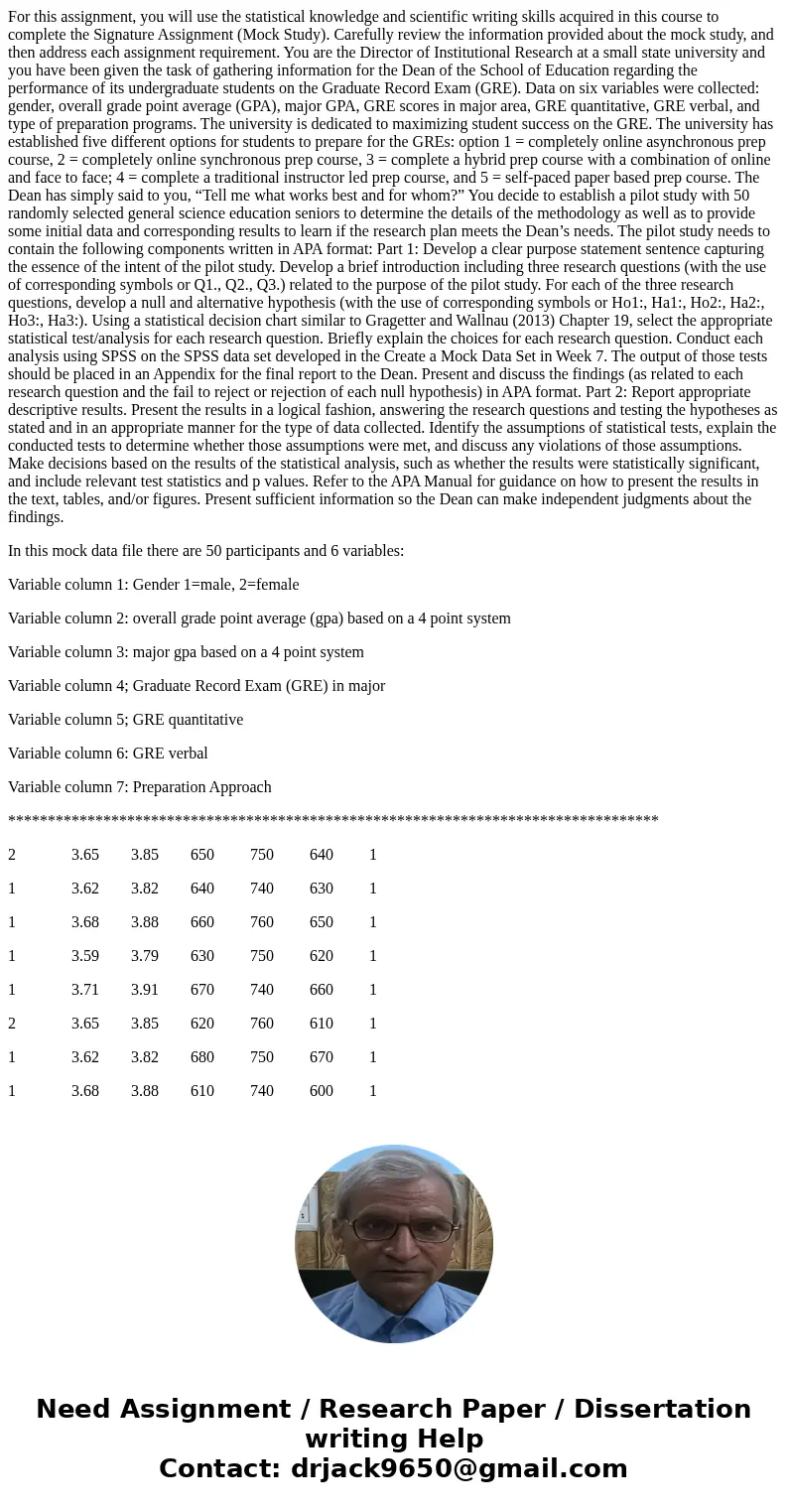
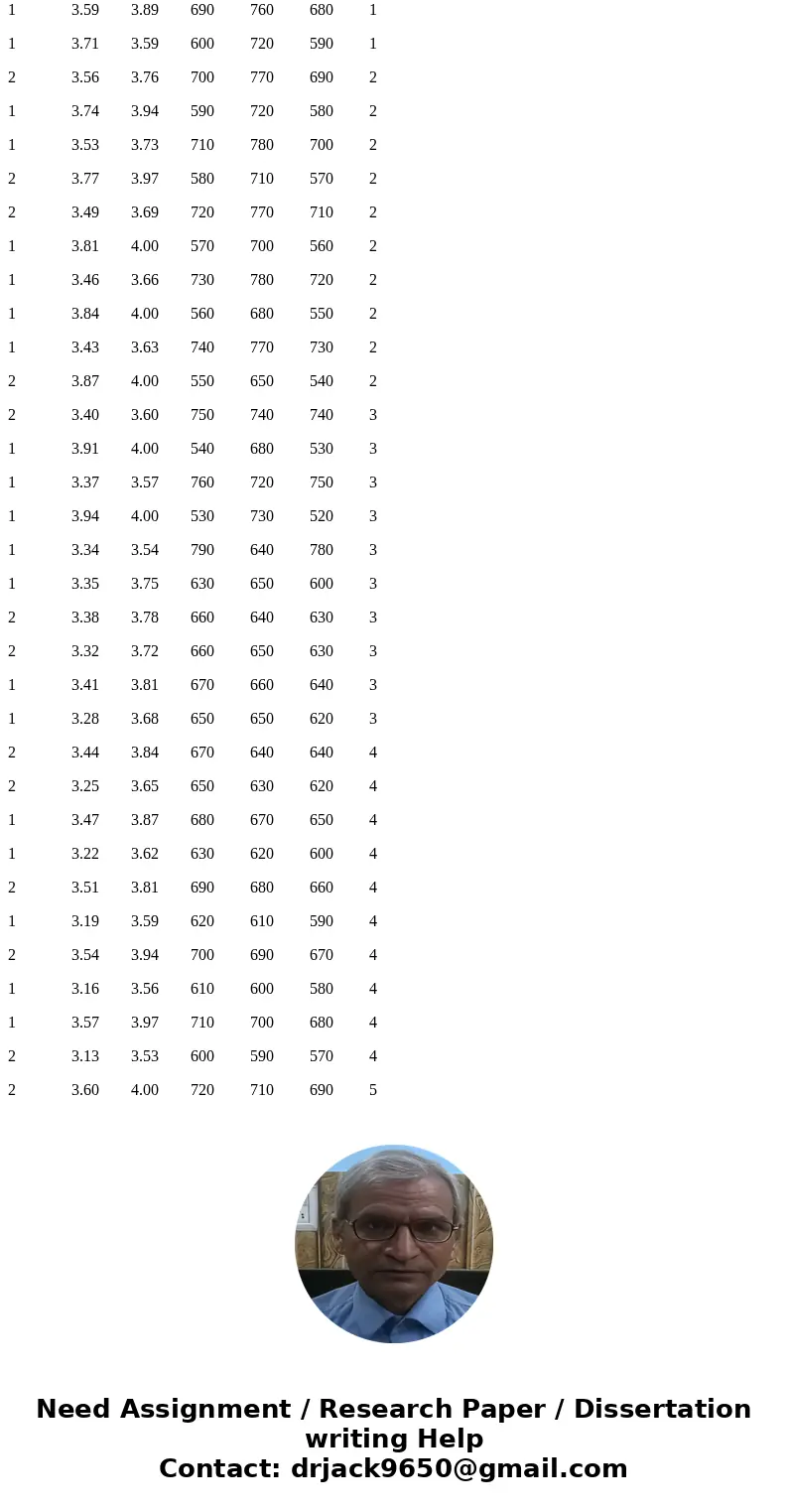
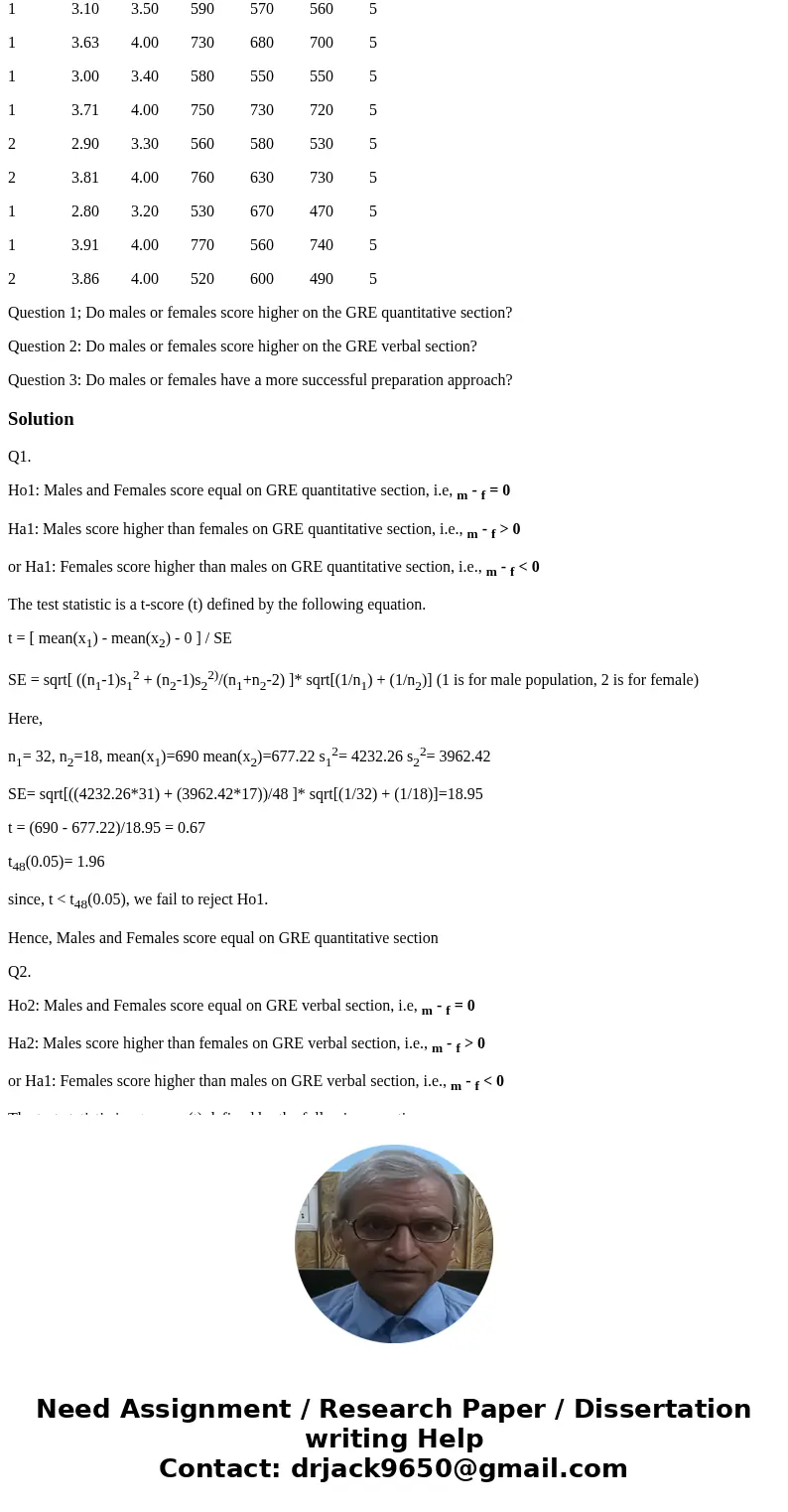
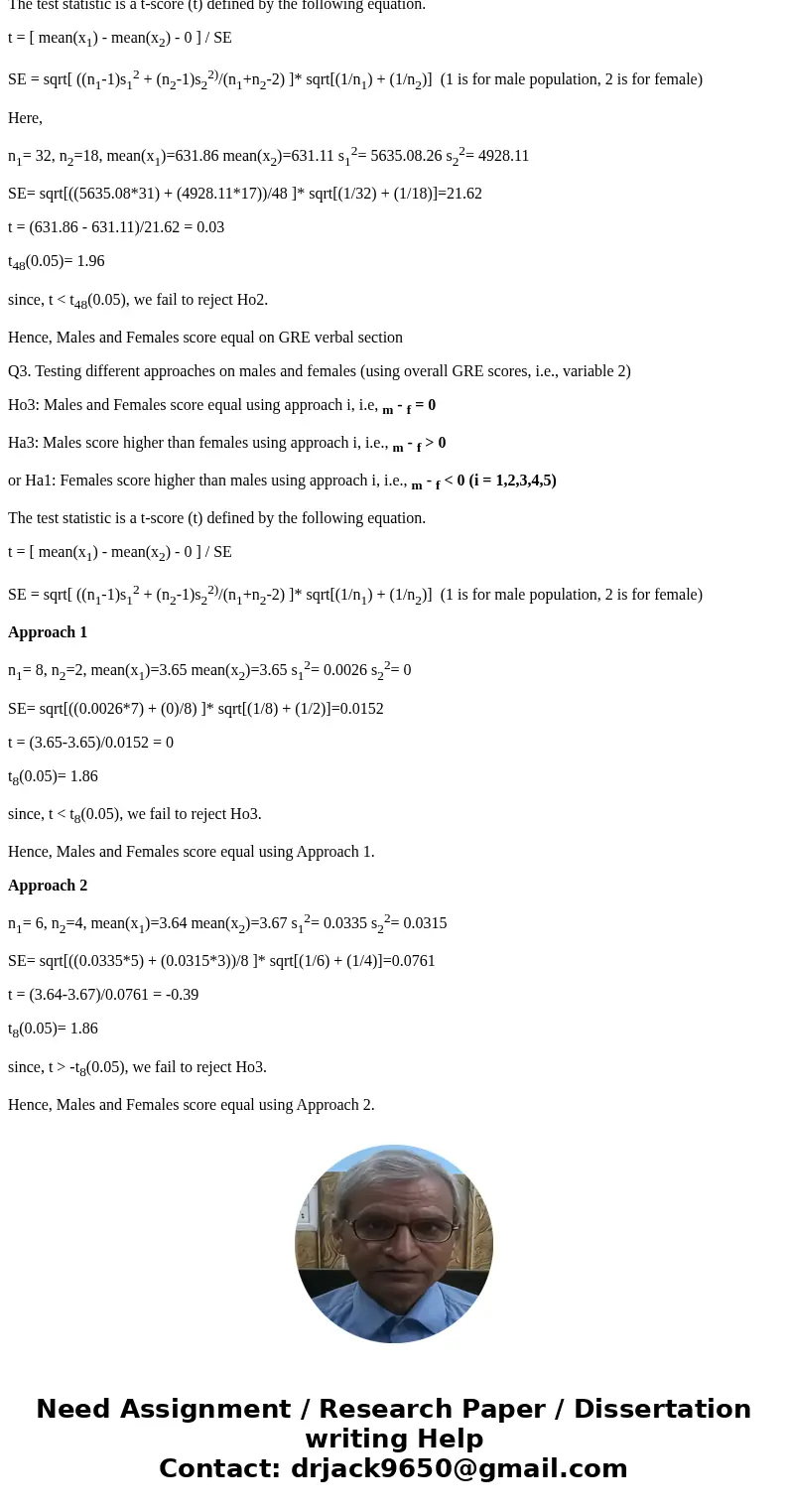
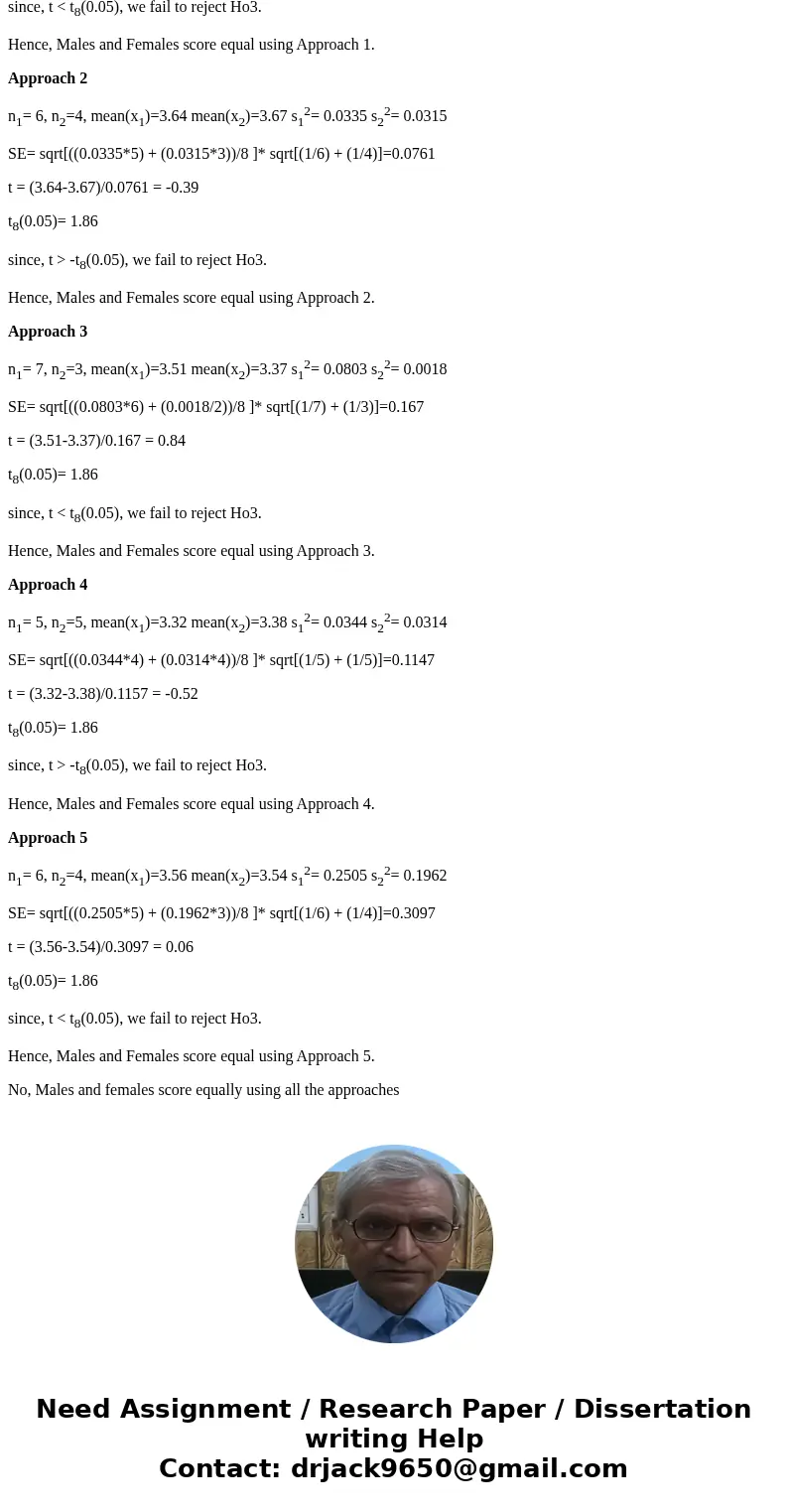
 Homework Sourse
Homework Sourse